 AD
AD
Today is: November 22
Scroll to explore events active on this date.
Additional Events on LEEP
LEEP INK FEATURES

August? Absolutely!
In August, we live through the Dog Days of Summer. It's hot and often humid, and those who can leave for better climates do. Down south, winter is in full force. August is also known as "the ...

In The Heat of July: July 2025 Events
Is it hot enough (or cold enough if you're below the equator) for you yet? There is actually a day for that! Like every month, I pick a diverse collection of events you may or may not know about. This ...

May Blooms: Events in May 2025
Along with October, May is one of the most densely packed months of the year. It's before the summer humidity and the last whole month of the school year. The weather is warming in t...
About America's Presidental Election Year
Civil Rights , United States
Ends: Nov 05, 2024
DESCRIPTION:
For those of us in the United States, the circus is in town—also known as the Presidential elections. Unlike other nations, America's presidential election cycle can be up to two years in length. That is two years of negative ads. Two years of posturing. Two years of campaign donation solicitations. Two years of sound bytes, verbal regurgitation, and competing bumper stickers. It's like watching a slow-moving sport for the rest of the world. Here in the US, we call it the circus.
The Presidential elections in the United States are a central feature of the country's democratic process and represent the method by which the President and Vice President are elected to office. Held every four years, these elections culminate in a complex and highly regulated process. As of the passage of the 22nd Amendment by Congress on March 21, 1947, a President can only be elected President twice in his or her lifetime. Additional requirements are that he or she be a natural-born citizen of the United States, 35 years or older, and not an active participant in insurrection or espionage against the United States.
The election begins with the primary elections and caucuses, where members of each political party vote to select their party's candidate, followed by national conventions, during which each party formally nominates its chosen candidate, who then selects a running mate to be the Vice Presidential candidate.
The general election occurs on Election Day, the Tuesday after the first Monday in November. United States citizens aged 18 and older can vote for their chosen candidate. However, the President is not directly elected by the popular vote. Instead, the United States uses an Electoral College system, wherein each state is allotted a specific number of electoral votes based on its population and representation in Congress.
Candidates vie to win these electoral votes, and the candidate who receives an absolute majority of the electoral votes, at least 270 out of 538, becomes the President-elect. The decision goes to the House of Representatives if no candidate receives an absolute majority.
The Electoral College system has sometimes led to discrepancies between the popular vote and the electoral vote, leading to debates and discussions around the fairness and effectiveness of the system. Notably, candidates have won the popular vote in some instances but lost the election due to the Electoral College distribution. The votes for the Electoral College are counted and certified by Congress on January 6 in a ceremonial count led by the current Vice President.
Following the election, the President-elect is inaugurated on January 20, marking the beginning of a four-year term. A President can serve a maximum of two terms.
The US Presidential elections attract global attention. They reflect the American people's values, concerns, and aspirations and often set the tone for the nation's domestic and foreign policies. With a blend of tradition and constant evolution, the Presidential elections continue to be a vital expression of American democracy.
VIDEOS
SUPPORTING DOCUMENTS
Currently, this event does not have supporting documents.
ADDITIONAL IMAGES
Currently, this event does not have supporting images.
Where would you like to go now?
 AD
AD


/footer-logo.svg)
